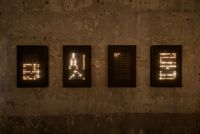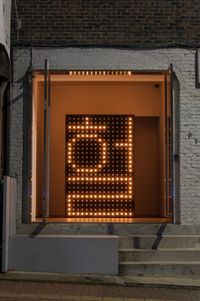

The duo Tacit Group has been prolifically active in Korea and overseas during the past decade or so, working primarily in the performance medium. The exhibition In-bitween at P21 is the fourth solo exhibition where they present viewers with installation work in a gallery setting. It includes 10 new pieces representing an expansion of the Hangul- and light-based artwork that has long been an area of focus for the two artists.
Tacit Group has adopted a performative approach to its artwork, using a wide variety of genres such as audio-visual performance, media installations, and algorithm art as it experiments with boundary crossing and the kind of diversity that is not reducible to binary divisions. The artists' work has the boundaries of sound and perspective coming into collision, breaking down the divisions between surface and meaning, between human expression and the expression of computer programming, and between completion and process. Part of this stems from the integrative nature of the digital media they use as both means and end, and it also bears connections with the endless collisions created by two artists coming from backgrounds in two different genres of music (classical and popular electronic).
In Tacit Group's work, characters in the Hangul writing system are used not as symbols to convey meaning, but as visual symbols representing a system of sounds. The images used in Tacit Group's work are all tools for visualizing the structural system of sounds produced by algorithm. In that sense, the emphasis is less on the moments in which characters are interpreted as they combine with a beat, and more on the moments in which the characters are decomposed and broken into segments, rendering meaning meaningless so that the sounds and perspectives themselves emerge as the 'meaning.' This also has associations with the essence of Tacit Group's work, which focuses on sound without 'purpose'—in contrast with visual images, which are defined by their constant attempts to create meaning.
In the context of art history, their work has parallels with minimalism in an external sense, while internally it has associations with abstract art and its abandonment of meaning and form to express the purity of shapes. Where the abstract paintings sought to achieve a utopian, purposeless aesthetic world through form and color, the Tacit Group artists approach this by means of computer bits and rhythmical beats. Abstract painters also used the technique of automatism as a way of bypassing human consciousness and accessing the unconscious; this bears similarities in the Tacit Group's method of 'objectified' artistic creation based on computer algorithms. Their work could be seen as a form of generative art based on the incorporation of a computer's unconsciousness (if such a term can be used).
When Tacit Group presents an installation work, it is characterized by its site-specificity and its interactions with the setting where it has been placed. That is also true for the P21 exhibition, which takes place in a window gallery that has been divided into two spaces: P2, which shows the structures of the old building, and P1, which appears as a clean white cube. The eight-part Filament,9X15,E10,20211217 in P1 is an installation work that uses the old medium of miniature filament bulbs, while the large single-character LED,15X23,E27,20211217 in P2 adopts the newer medium of LED bulbs. In addition to this contrast between old and new spaces and medium concepts, the exhibition also uses a window to connect between inside and outside so that the work can be seen not just by visitors to the gallery, but also by people passing by along the street.
The sounds emanating from the artwork in these two different spaces are combined together in a small space behind the P2 section to form a new work titled 1+2 Listening Room. This space is a sound installation without any sort of visual symbols. While this is a sound-based artwork situated in an exhibition setting, it remains unclear whether the artists' work can be classified as 'sound art' as the term is used in contemporary art. In its narrow sense, sound art is a contemporary art genre in which sound is used as an artistic medium. Yet Tacit Group outright rejects the sorts of interpretations assigned in contemporary art, focusing more on creating layers and depths of sound that are only audible to the listener—much like the depths of contemporary art that can only be perceived by the viewer.
In-bitween opens its doors as darkness is falling, and the artwork in it may seem similar to constellations in the night sky. Humankind has long strived to discover patterns and find meaning in the stars. But the constellations in this artwork are constantly being transformed by computer algorithms; any meaning that does form immediately dissipates and disappears. Moments are separated into a sequence of miniature lightbulb points, deconstructing meaning to create instants where meaninglessness itself becomes the 'meaning.' A state of constantly becoming something while refusing to be defined by anything; a state of continuous formation and reshaping. Through their long and difficult performative programming process, the artists of Tacit Group may be discovering the essence of 'creation' by rejecting any kind of form and embracing the instability that comes from not being confined by categories or interpretations.
Press release courtesy P21.
66, Hoenamu-ro
Yongsan-gu
Seoul, 04346
South Korea
p21.kr
+82 2 790 5503
+82 2 790 5504 (Fax)
Tuesday – Friday
11am – 6pm
Saturday
12pm – 6pm